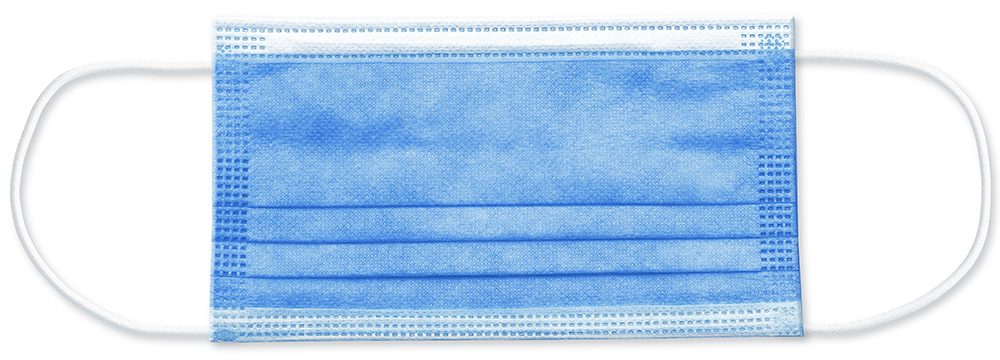 Whether the obligation to wear a respiratory mask outside the house can mitigate the risks of infection in a meaningful way is currently the subject of hot debate. Wearing a face mask in public will not become compulsory. However, the federal government and the federal states recommend wearing a face mask when taking public transport and shopping. Those who want to be in the know should become familiar with the basic information on what respiratory masks do. Are different types of face masks available and, if so, what are they? What are the major differences between mouth-nose protection (MNP) and a filtering face piece ? Should you make or sew your own face masks?
Whether the obligation to wear a respiratory mask outside the house can mitigate the risks of infection in a meaningful way is currently the subject of hot debate. Wearing a face mask in public will not become compulsory. However, the federal government and the federal states recommend wearing a face mask when taking public transport and shopping. Those who want to be in the know should become familiar with the basic information on what respiratory masks do. Are different types of face masks available and, if so, what are they? What are the major differences between mouth-nose protection (MNP) and a filtering face piece ? Should you make or sew your own face masks?
Not all masks are the same. We found that out in the general discussion already. But the actual complexity of a respiratory mask becomes evident by taking a look at the documentation made available by Germany’s Federal Institute for Occupational Safety and Health (BAuA). The specification of possible protective equipment thus encompasses 8 types in total. This is followed by distinctions regarding its importance to the wearer or to those involved, the objectives of use and reprocessing, as well as activities on patients without or with suspected Covid-19. We clear the path through this thicket of statutory regulations:
What’s the difference between mouth-nose protection and a filtering face piece?
Mouth-nose protection (MNP) is also known as a surgical mask/medical mask or face mask. Mouth-nose protection is not respiratory protection, but first and foremost reduces the chance of potentially infectious saliva or mucus droplets being released into the environment from the wearer. The thin masks consist of a filter layer embedded between two layers of fabric. Since the mask is not close fitting, it does not provide sufficient protection against any airborne infection. However, the mouth and nose of the wearer can be protected by the mask from coming into contact with contaminated hands.
Mouth-nose protection
The filtering face piece (FFP) protects the wearer against solid or liquid aerosols. Depending on the retention capacity of the particulate filter, the FFP mask is standardised differently and categorised in FFP1, FFP2 and FFP3 device classes. FFFP2 class masks or higher are suitable protection against infectious aerosols, including viruses. Provided they are tightly fit!
Filtering face piece
Which respiratory masks protect against SARS-CoV-2?
Filtering face pieces are, depending on their respective particle retention capacity, categorised according to three device classes: FFP1, FFP2 and FFP3. Masks from class FFP2 protect the wearer against CMW substances (substances that are carcinogenic, mutagenic, toxic to reproduction) and radioactive substances such as airborne biological agents that are categorised in risk group III.
The US federal agency NIOSH (National Institute for Occupational Safety and Health), which is comparable to the UK’s Health and Safety Executive, has defined standards for filtering face pieces comparable to the German equipment class. The US agency also makes a distinction based on the respective retention capacity, and designates the equipment classes with the letters N, R and P.
When comparing the filter retention capacity of FFP2 masks according to the European standard and the US N95 masks, we can assume virtually identical performance characteristics.
Can I make or sew medical face masks (mouth-nose protection, MNP) myself?
The main argument in the current discussion is that any mask is better than no mask. Consequently, numerous patterns can be found on the Internet for sewing face masks yourself. It is important to be firstly aware of this: A moisture-saturated mask does not protect anyone, but increases the risk of infection. And secondly: Is it really worthwhile to sew your own masks when you urgently need to change them after they become saturated?
MNP and home-made face masks are not respiratory protection!
Please note that MNP as well as home-made masks do not fit tightly and the materials used for them do not meet the protective performance requirements of personal protective equipment.
Beware of a false sense of safety!
Wearing an MNP should in no way lead you to violate social distancing rules or no longer implement hand hygiene practices.
Protecting others
However, the mouth and nose of the wearer can be protected from contact with contaminated hands by MNP and probably by masks made by the wearer as well. Home-made face masks can act like MNP at best, and primarily reduce the risk of (potentially infectious) droplets entering the environment from the wearer’s saliva/mucus.
Disposable mouth-nose mask now available from us
In some countries such as Austria shoppers are required to wear a mask. However, Jena in Thuringia was the first German city to mandate the wearing of masks in supermarkets, public transport and buildings frequented by the public. Other municipalities in Thuringia are planning similar steps. Bavaria’s Minister President Markus Söder also considers it “highly likely” that his state will make masks compulsory.



